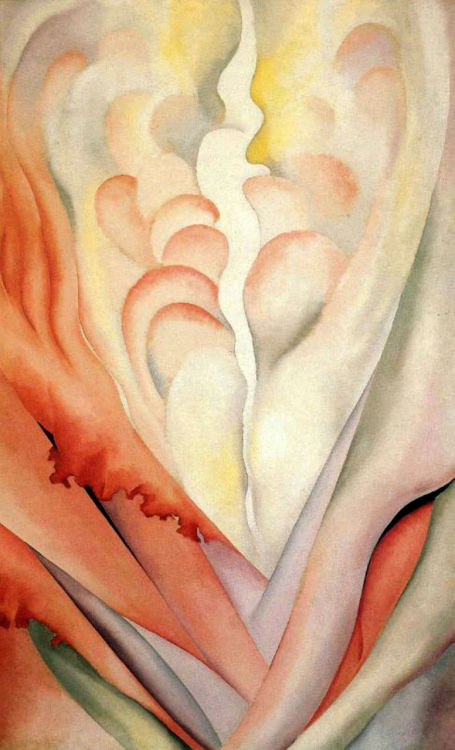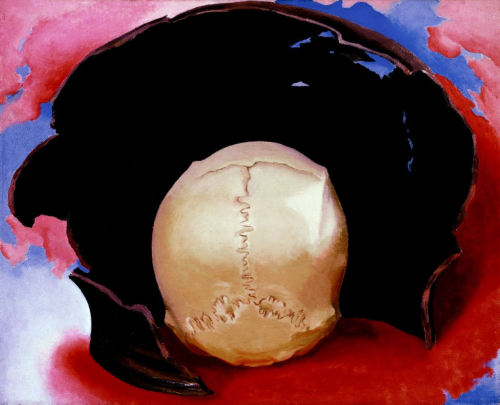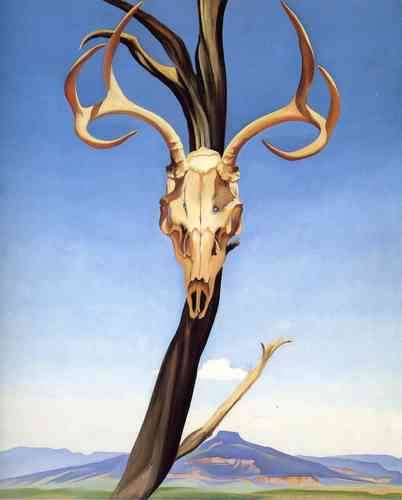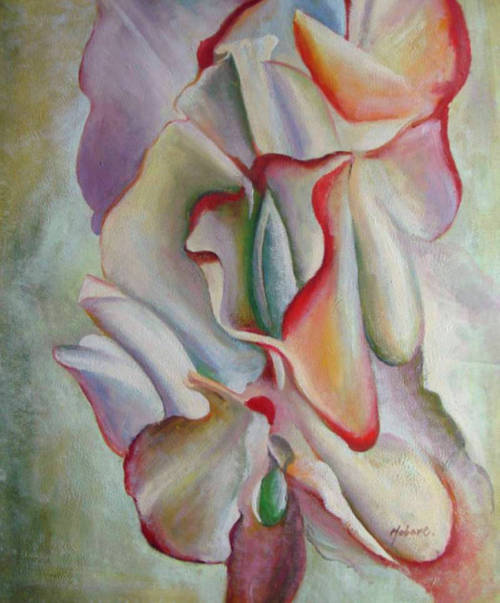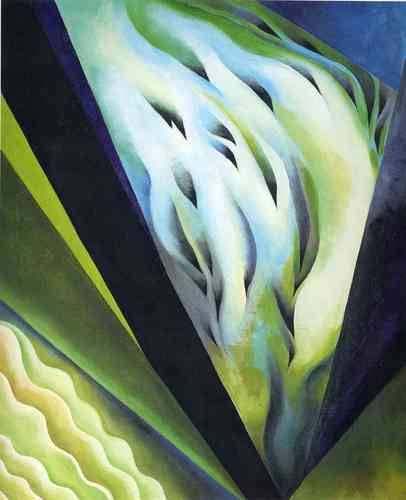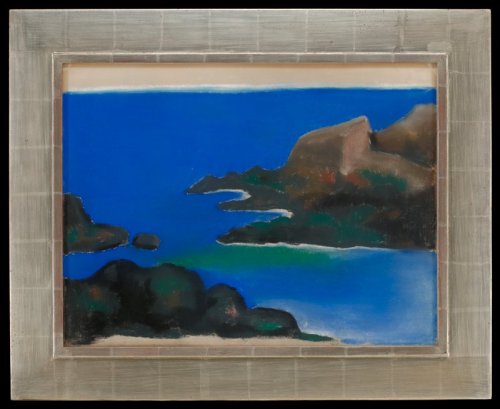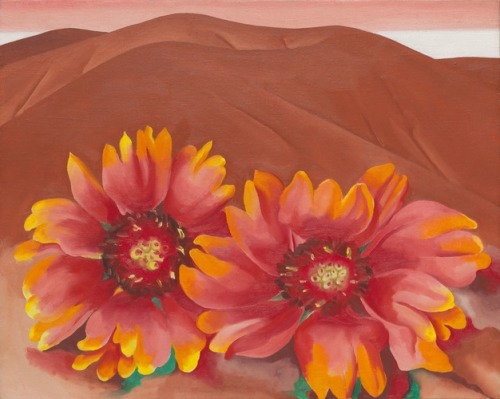#georgiaokeeffe
Blue and Green Music, Georgia O'Keeffe, 1919,Art Institute of Chicago: American Art
Around 1920 Georgia O’Keeffe painted a number of oils exploring, as she later recalled, “the idea that music could be translated into something for the eye.” In Blue and Green Music, O’Keeffe’s colors and forms simultaneously suggest the natural world and evoke the experience of sound. She was drawn to the theories of the Russian Expressionist painter Vasily Kandinsky, who, in his 1912 text Concerning the Spiritual in Art, argued that visual artists should emulate music in order to achieve pure expression free of literary references. Alfred Stieglitz Collection, gift of Georgia O'Keeffe
Size: 58.4 × 48.3 cm (23 × 18 in.)
Medium: Oil on canvas
https://www.artic.edu/artworks/24306/
Post link
The White Place in Sun, Georgia O'Keeffe, 1943,Art Institute of Chicago: American Art
Georgia O’Keeffe could see the dramatic geological formation known as the White Place, or Plaza Blanca, from a window in her home near Abiquiu, New Mexico. Composed of white stone that provides a stark contrast to the colors of the surrounding terrain, the White Place was whittled and smoothed by water and wind over centuries into a striking formation resembling columns, cliffs, and spires. O’Keeffe painted it a number of times, and in The White Place in Sun, she selected a view that emphasizes a deep cleft in the formation. The V-shaped composition enabled her to focus on the interplay between the brilliant blue sky, the eerie white color, and horizontal striations of the carved rock. Bequest of Paul and Gabriella Rosenbaum
Size: 71.1 × 55.9 cm (28 × 22 in.)
Medium: Oil on canvas
https://www.artic.edu/artworks/158752/
Post link
Blue Sea with Rocks, Georgia O'Keeffe, 1922,Minneapolis Institute of Art: Prints and Drawings
41 pastel drawing of a bright blue sea with patches of brown rocks; touch of green at center Georgia O’Keeffe had a special talent for defining the essential character of a place. Throughout her life, she was attracted to places that represented extremes—the man-made canyons in New York City and the desert landscapes of the Southwest. In the 1920s she made several summer visits to York Beach, Maine, finding refuge from the heat and hustle of New York. Blue Sea with Rocks is from her third season there, in 1922. At first glance the composition reads as a flat image—perhaps pure abstraction. Then the flatness shifts and becomes infinite depth as we note the white streak marking the horizon. Colors catch our attention—greens in the water and brown, green, and lavender in the rocks. The deep blue of the open ocean fades to lighter tones in the shallow cove. The brown face of the upper rock reveals that the light comes from over the artist’s right shoulder. Abstraction, which earlier in O’Keeffe’s career had been a pure pursuit, has given way to a portrait of a bright summer afternoon.
Size: 18 ¾ × 24 ¾ in. (47.63 × 62.87 cm) (sight) 19 × 25 in. (48.26 × 63.5 cm) (sheet) 26 × 32 × 1 ¼ in. (66.04 × 81.28 × 3.18 cm) (outer frame)
Medium: Pastel
https://collections.artsmia.org/art/118697/
Post link
Black Place I, Georgia O'Keeffe, 1945,Minneapolis Institute of Art: Paintings
abstract landscape-like imagery; grey, black, and dark pink rolling forms with scalloped cloud-like shapes in foreground Georgia O’Keeffe, one of the most admired American Modernist painters of the 1900s, drew inspiration from the landscape of the American Southwest. Among her favorite places to paint was a site she called “the Black Place,” in the Bisti Badlands in Navajo country, a barren stretch of weathered hills that O’Keeffe said looked like “a mile of elephants” from a distance.
Size: 29 5/8 × 35 11/16 in. (75.25 × 90.65 cm) (sight) 30 ¼ × 36 ¼ × 1 ¼ in. (76.84 × 92.08 × 3.18 cm) (outer frame)
Medium: Oil on canvas
https://collections.artsmia.org/art/119128/
Post link
Red Hills with Flowers, Georgia O'Keeffe, 1937,Art Institute of Chicago: American Art
Fascinated by contrasts in scale, Georgia O’Keeffe frequently juxtaposed enlarged still-life elements with far-off landscapes, as seen in Black Cross, New Mexico. She continued this practice in Red Hills with Flowers, an image of vibrant flowers magnified and set against the red hills that surrounded her New Mexico home. The striking colors of the land intrigued her, and she later equated the area’s myriad hues with artist paints: “All the earth colors of the painter’s palette are out there in the many miles of badlands. The light Naples yellow through the ochers—orange and red and purple earth—even the soft earth greens.” Bequest of Hortense Henry Prosser
Size: 50.8 × 63.5 cm (20 × 25 in.)
Medium: Oil on canvas
https://www.artic.edu/artworks/118577/
Post link
Purple Petunias, 1925,Georgia O'Keeffe
https://www.wikiart.org/en/georgia-o-keeffe/purple-petunias
Post link
Abstraction Blue, Georgia O'Keeffe, 1927,MoMA: Painting and Sculpture
Acquired through the Helen Acheson Bequest
Size: 40 ¼ x 30" (102.1 x 76 cm)
Medium: Oil on canvas
http://www.moma.org/collection/works/78677
Post link



